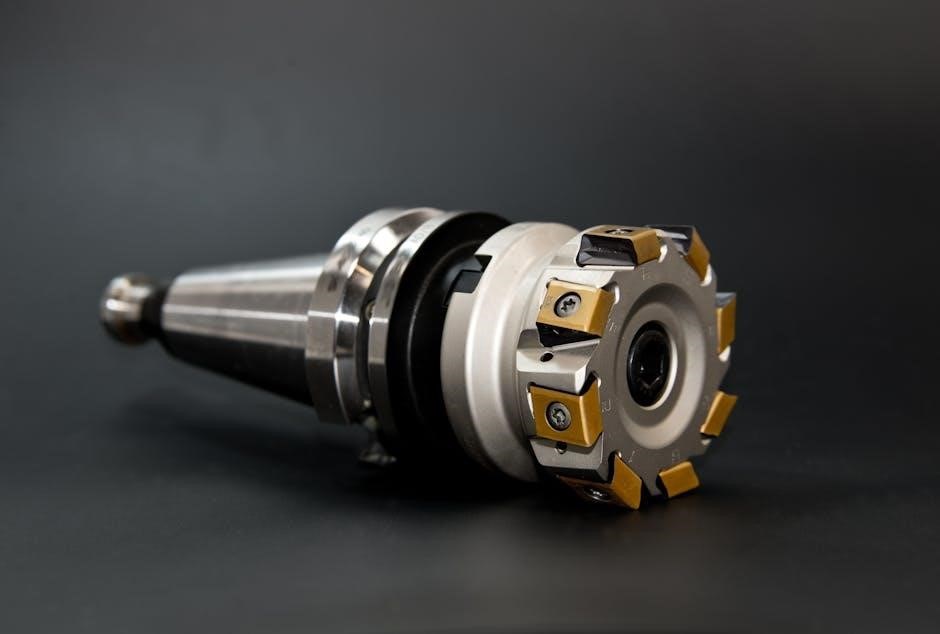This section introduces milling machine manuals, essential guides for understanding machine operation, safety, installation, and maintenance. These manuals ensure safe and effective use of milling equipment.
1.1 Purpose and Scope of the Manual
This manual serves as a comprehensive guide for milling machine operation, covering installation, maintenance, and safety protocols. It provides detailed instructions for optimal machine performance and troubleshooting. The scope includes operational procedures, safety measures, and technical specifications to ensure safe and efficient use of the milling machine. This manual is essential for operators, technicians, and maintenance personnel to understand and apply best practices effectively.
1.2 Importance of Following Instructions
Adhering to the manual’s instructions is crucial for safe and effective milling machine operation. Proper procedures prevent accidents, ensure precise workmanship, and extend machine lifespan. Neglecting guidelines can lead to equipment damage or personal injury. Operators must thoroughly understand and follow all instructions to maintain productivity and safety in the workshop environment.

Safety Precautions and Guidelines
Safety is paramount when operating milling machines. Always wear protective gear, ensure covers are in place, and follow proper waste disposal procedures to maintain a safe environment.
2.1 General Safety Rules for Milling Machines
Operating a milling machine requires adherence to strict safety protocols. Always wear safety glasses, gloves, and appropriate clothing. Ensure all guards are in place and the machine is properly grounded. Never operate the machine without proper training, and keep loose clothing tied back. Regularly inspect tools and machinery before use to prevent accidents. Follow the manual’s guidelines meticulously for safe operation.
2.2 Safety Equipment and Protective Gear
Essential safety equipment includes safety glasses with protective lenses, gloves, and closed-toe shoes. Use face shields for operations involving flying particles. Hearing protection is necessary for loud environments. Ensure proper ventilation and use splash guards when cutting oils are present. Regularly inspect all protective gear for damage. Adhere to manufacturer guidelines for equipment use to maintain a safe working environment and prevent injuries during milling operations.

Installation and Setup of the Milling Machine
This section provides a comprehensive guide for installing and setting up milling machines, including pre-installation checks and step-by-step procedures to ensure proper machine functionality and safety.
3.1 Pre-Installation Checks and Requirements
Before installing a milling machine, conduct thorough pre-installation checks to ensure compliance with manufacturer specifications. Verify the machine’s serial number, check for damage, and confirm all components are included. Ensure the installation site meets power, space, and environmental requirements. Review the manual for specific guidelines to guarantee a safe and proper setup process.
3.2 Step-by-Step Installation Process
Begin by positioning the milling machine on a level, stable surface. Connect the power supply as specified in the manual. Install any necessary accessories and ensure all components are securely fastened. Follow the manual’s sequence for aligning and calibrating the machine. Perform a test run to verify proper operation. Consult the manual for troubleshooting any issues during installation to ensure optimal functionality and safety.
Operating the Milling Machine
Operating the milling machine involves engaging the spindle, setting appropriate speeds, and using controls to position the workpiece accurately. Always follow manual guidelines for safe and efficient operation.
4.1 Understanding Machine Controls and Functions
Understanding machine controls is crucial for effective operation. Familiarize yourself with the feed handwheel, which moves the quill up or down. The spindle speed selector allows adjustment of RPMs, while the quill stop knob limits vertical movement. Always refer to the manual to ensure proper use of these controls for precise milling operations and safety.
4.2 Performing Basic Milling Operations
Begin by securing the workpiece using clamps or a vise. Select the appropriate milling cutter and attach it to the spindle. Set the desired spindle speed based on the material and cutter type. Engage the spindle and carefully feed the cutter into the workpiece. Use cutting oil to prevent overheating and ensure precise cuts. Always follow manual guidelines for safe and accurate milling operations.
Maintenance and Troubleshooting
Regularly clean and lubricate moving parts, check alignment, and replace worn components. Refer to the manual for troubleshooting common issues and routine maintenance procedures.
5.1 Routine Maintenance Procedures
Regular maintenance ensures optimal performance and longevity of the milling machine. Clean and lubricate moving parts, check spindle alignment, and inspect tools for wear. Replace components as needed and follow the manual’s maintenance schedule. Proper care prevents downtime and maintains precision. Always refer to the manufacturer’s guidelines for specific procedures and recommendations.
5.2 Common Issues and Troubleshooting Tips
Common issues with milling machines include vibrations, misalignment, and overheating. Check spindle alignment and tighten loose parts; Ensure tools are sharp and properly secured. Monitor coolant levels and clean debris regularly. For persistent problems, consult the manual or contact a professional. Regular inspections and timely repairs can prevent major breakdowns and ensure smooth operation.

Milling Machine Tools and Accessories
Milling machines utilize various tools like end mills, face mills, and drill bits. Accessories include vises, clamps, and coolant systems, enhancing precision and versatility in operations.
6.1 Types of Milling Cutters and Their Uses
Milling cutters vary in design, including end mills, face mills, and ball nose mills. End mills are used for profiling and slotting, while face mills handle large surface areas. Specialized cutters like dovetail and corner radius mills are for intricate shapes. Each type is tailored for specific tasks, ensuring efficiency in metalworking projects.
6.2 Setting Up and Using Accessories
Proper setup of milling machine accessories like vises, clamps, and cutting tools is crucial for precise operations. Ensure the workpiece is securely fastened to prevent movement. Align tools correctly and use appropriate fixtures for stability. Always follow the manual’s guidelines for accessory installation and operation to maintain safety and achieve optimal results. Regularly inspect accessories for wear and replace them as needed.

CNC Milling Machine Manual Operations
CNC milling machines require precise programming and operation to ensure accuracy. Follow the manual for setup, tool selection, and safety protocols to achieve optimal results efficiently.
7.1 Programming and Operating CNC Mills
Programming and operating CNC milling machines involves understanding G-codes, setting parameters, and ensuring precise tool paths. Always follow safety guidelines, such as wearing protective gear and keeping guards in place. Properly inputting programs and verifying simulations before operation is crucial. Regularly inspect tools and materials to maintain accuracy and efficiency. Shutdown procedures should be followed meticulously to prevent damage or accidents.
7.2 Understanding CNC Milling Machine Controls
Mastering CNC milling machine controls is vital for precise operations. Key components include the control panel, feed rate adjustment, spindle speed settings, and emergency stop buttons. Understanding G-code programming and machine feedback ensures accurate tool paths. Familiarize yourself with manual and CNC modes, as well as safety features like emergency stops and guard interlocks. Always follow manufacturer guidelines for optimal performance and safety.
Manufacturer-Specific Guidelines
Adhere to manufacturer instructions for optimal performance and safety. Guidelines vary by brand and model, ensuring compatibility and compliance with specific milling machine requirements and standards.
8.1 Bridgeport Series I Milling Machine Specifications
The Bridgeport Series I milling machine is a versatile tool designed for precision milling. Key specifications include variable spindle speeds, a robust knee-and-column design, and a wide range of optional accessories. Its compact footprint makes it ideal for workshops with limited space. The machine’s serial number is crucial for identifying compatible parts and ensuring proper maintenance.
8.2 Compliance with Manufacturer Instructions
Adhering to manufacturer instructions is crucial for safe and efficient operation of milling machines. Proper compliance ensures equipment longevity, prevents accidents, and maintains warranty validity. Always follow installation, operation, and maintenance guidelines as outlined in the manual. Deviating from instructions can lead to unsafe conditions or machine damage, emphasizing the importance of strict adherence to manufacturer-recommended practices and specifications.
Advanced Milling Techniques
Explore advanced milling methods to enhance precision and efficiency. Learn specialized techniques for complex geometries and high-tolerance projects. Optimize tool selection and parameter settings for superior results.
9.1 Precision Milling and Finishing Techniques
Precision milling involves achieving high accuracy and surface finish. Techniques such as climb milling, high-speed machining, and minimal material removal ensure dimensional tolerance. Finishing methods like polishing or diamond-cutting enhance surface quality. Proper coolant application and tool geometry selection are emphasized for optimal results. These techniques are critical for producing parts with tight specifications and extended tool life.
9.2 Optimizing Milling Operations for Efficiency
Optimizing milling operations involves selecting the right tools, maintaining proper spindle speeds, and ensuring precise feed rates. Using automation tools and reducing unnecessary material waste enhances productivity. Regular maintenance of the machine and tooling further improves efficiency. By streamlining workflows and adhering to best practices, operators can achieve higher output while minimizing downtime and material costs, ensuring cost-effective and precise milling processes.
Environmental and Health Considerations
Proper disposal of metal chips and cleaning of cutting oils are crucial for environmental safety. Handling coolants and waste materials responsibly prevents health hazards and ecological damage.
10.1 Proper Waste Disposal and Cleanup
Dispose of metal shavings and machining byproducts in designated containers to prevent environmental contamination. Regularly clean the machine and surrounding area to avoid dust buildup. Use appropriate safety gear during cleanup to minimize exposure to hazardous materials. Ensure all waste materials are recycled or disposed of according to local regulations and safety standards for a sustainable workshop environment.
10.2 Managing Cutting Oils and Coolants
Store cutting oils and coolants in sealed containers to prevent contamination and spills. Use appropriate splash guards to minimize exposure during machining. Dispose of used fluids according to environmental regulations to avoid ecological harm. Regularly inspect and maintain oil systems to ensure optimal performance and safety, adhering to manufacturer guidelines for handling and application of these essential machine lubricants.
Training and Certification
Proper training ensures operators understand milling machine functions, safety, and maintenance. Certification programs validate competence, ensuring safe and efficient machine operation.
11.1 Operator Training Requirements
Operators must complete comprehensive training to understand milling machine functions, safety protocols, and maintenance procedures. Training includes theoretical knowledge and hands-on practice. Certification is required to ensure operators can safely and effectively use the machine. Regular updates and assessments are necessary to maintain proficiency and adapt to new technologies or procedures.
11.2 Certification Programs for Milling Machine Operators
Certification programs validate operators’ expertise in milling machine operation, safety, and maintenance. These programs include standardized tests and practical demonstrations. Certification ensures operators meet industry standards, enhancing workplace safety and efficiency. Renewal requirements maintain competency and adapt to technological advancements. Certified operators are recognized for their proficiency, contributing to overall production quality and compliance with safety regulations.
This manual provides comprehensive guidance for milling machine operation, safety, and maintenance. For further learning, explore manufacturer websites, industry forums, and specialized machining resources online.
12.1 Summary of Key Takeaways
This manual provides essential insights into milling machine operations, emphasizing safety, proper setup, and maintenance. Key takeaways include understanding machine controls, adhering to safety protocols, performing routine maintenance, and optimizing milling techniques. Operators should always follow manufacturer guidelines and seek additional resources for advanced learning. Proper training and certification are crucial for efficient and safe milling operations. Refer to recommended readings for further technical details and best practices.
12.2 Recommended Reading and Online Resources
For further learning, explore manufacturer websites like me.ucr.edu and official manuals from brands like Bridgeport and Hardinge. Technical guides, such as the Bridgeport Series I Milling Machine Manual, offer detailed insights. Online forums and tutorials on CNC milling are also valuable. Stay updated with industry publications and safety standards to enhance your milling machine operations and troubleshooting skills effectively.
